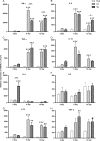Heat shock protein-27 delays acute rejection after cardiac transplantation: an experimental model
- PMID: 24879379
- PMCID: PMC4164282
- DOI: 10.1097/TP.0000000000000170
Heat shock protein-27 delays acute rejection after cardiac transplantation: an experimental model
Abstract
Background: Rejection is the major obstacle to survival after cardiac transplantation. We investigated whether overexpression of heat shock protein (Hsp)-27 in mouse hearts protects against acute rejection and the mechanisms of such protection.
Methods: Hearts from B10.A mice overexpressing human Hsp-27 (Hsp-27tg), or Hsp-27-negative hearts from littermate controls (LCs) were transplanted into allogeneic C57BL/6 mice. The immune response to B10.A hearts was investigated using quantitative polymerase chain reaction for CD3+, CD4+, CD8+ T cells, and CD14+ monocytes and cytokines (interferon-γ, interleukin [IL]-2, tumor necrosis factor-α, IL-1β, IL-4, IL-5, IL-10, transforming growth factor-β) in allografts at days 2, 5, and 12 after transplantation. The effect of Hsp-27 on ischemia-induced caspase activation and immune activation was investigated.
Results: Survival of Hsp-27tg hearts (35±10.37 days, n=10) was significantly prolonged compared with LCs (13.6±3.06 days, n=10, P=0.0004). Hsp-27tg hearts expressed significantly more messenger RNA (mRNA) markers of CD14+ monocytes at day 2 and less mRNA markers of CD3+ and CD8+T cells at day 5 compared with LCs. There was more IL-4 mRNA in Hsp-27tg hearts at day 2 and less interferon-γ mRNA at day 5 compared with LCs. Heat shock protein-27tg hearts subjected to ischemia or to 24 hr ischemia-reperfusion injury demonstrated significantly less apoptosis and activation of caspases 3, 9, and 1 than LCs. T cells removed from C57BL/6 recipients of Hsp-27tg hearts produced a vigorous memory response to B10.A antigens, suggesting immune activation was not inhibited by Hsp-27.
Conclusion: Heat shock protein-27 delays allograft rejection, by inhibiting tissue damage, through probably an antiapoptotic pathway. It may also promote an anti-inflammatory subset of monocytes.
Conflict of interest statement
The authors declare no conflicts of interest.
Figures





References
-
- Sulemanjee NZ, Merla R, Lick SD, et al. The first year post-heart transplantation: use of immunosuppressive drugs and early complications. J Cardiovasc Pharmacol Ther 2008; 13: 13. - PubMed
-
- Fink AL. Chaperone-mediated protein folding. Physiol Rev 1999; 79: 425. - PubMed
-
- Arrigo AP, Welch WJ. Characterization and purification of the small 28,000-dalton mammalian heat shock protein. J Biol Chem 1987; 262: 15359. - PubMed
-
- Landry J, Lambert H, Zhou M, et al. Human HSP27 is phosphorylated at serines 78 and 82 by heat shock and mitogen-activated kinases that recognize the same amino acid motif as S6 kinase II. J Biol Chem 1992; 267: 794. - PubMed
-
- Arrigo AP. The cellular “networking” of mammalian Hsp27 and its functions in the control of protein folding, redox state and apoptosis. Adv Exp Med Biol 2007; 594: 14. - PubMed
Publication types
MeSH terms
Substances
Grants and funding
LinkOut - more resources
Full Text Sources
Other Literature Sources
Medical
Research Materials
Miscellaneous

